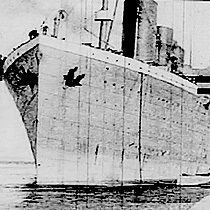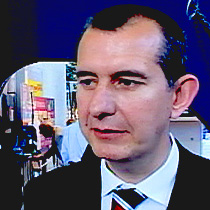2007年VOA标准英语-Titanic: The Beginnings in Belfast(在线收听)
Washington, D.C.
11 July 2007
On April 15, 1912 the world's largest ocean liner -- "Titanic" -- struck an iceberg and sank on her maiden voyage from England to the United States. Hundreds of lives were lost. The story of the Titanic's fateful voyage is known around the world, partly as the result of a blockbuster Hollywood film.
But relatively little attention has been paid to the ship's history in Belfast, Northern Ireland, where she was designed, built and launched. Now a new exhibit is remembering the "Titanic in Belfast" and the Northern Irish people who built her. For producer George Dwyer, VOA's Jim Bertel has more.
 |
| The Titanic |
Fascination with the epic story of the supposedly unsinkable ocean liner has run high ever since she sank nearly 100 years ago. Recently there was new proof that interest remains strong as the National Museums Northern Ireland opened an exhibit on the history of the Titanic in Belfast at Washington D.C.'s Union Station rail terminal.
"It tells a story that I think will stretch the heart of people everywhere,” says National Museums' Board of Trustees Chairwoman Margaret Elliott. “Everyone knows a little about Titanic. I wonder if they know that it was actually built in Belfast."
The exhibit features video images and graphics to tell the story of Titanic's construction in a city which, says National Museums' Chief Executive Tim Cooke, was once a global center of technological innovation and is striving to become so once again.
"Now almost 100 years later Belfast has emerged from three decades of well-publicized conflict,” says Cooke. “Now, thankfully, in a consolidating post-conflict era, the real energy of the city and its people is shining through once more."
Images of Belfast today, as it emerges from its troubled history of sectarian conflict, illustrate its efforts to embrace new opportunities for business and tourism. Northern Ireland's Minister for Culture, Arts, and Leisure Edwin Poots says plans are underway for Belfast to reclaim its industrial pre-eminence.
|
|
| Edwin Poots |
"Now that we have put the trouble behind us the international community is interested in coming to Northern Ireland, they are interested in investing in Northern Ireland,” says Poots. “There is a potential for job creation and there is a potential for wealth creation, and international companies are clearly interested in doing that. And that is one of the benefits of moving out of a post-conflict situation."
One reconstruction project involves the creation of a "Titanic Quarter" in Belfast, a gateway development zone designed to attract international investment. Naming it after the great ship that was built nearby would seem to complete the journey of a ship that symbolized triumph, then tragedy, and now rebirth.
